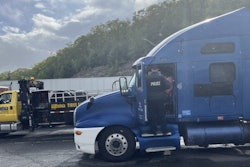Eight years after the governments of the United States, Canada and Mexico signed the North American Free Trade Agreement, the treaty continues to generate fierce debate.
The most recent NAFTA battleground involves the trucking industry, as Congress recently passed bills designed to slow down the Bush administration’s stated goal of implementing the treaty and opening the U.S. border to Mexican truckers by January.
In 1995, U.S. and Mexican truckers were given access to cross-border commercial zones, usually within 20 miles of the border. Under terms of NAFTA, the border was to have been open to trucks engaged in NAFTA trade in 2000, but the Clinton administration, under intense lobbying from the Teamsters and other unions, ignored the 2000 deadline and kept the border closed. Mexico went to a special NAFTA arbitration panel, which ruled the United States must allow access to Mexican carriers engaged in international trade. The panel did say the United States could impose certain requirements to ensure safety.
Following the panel’s ruling, Bush said he would abide by its decision and instructed the Federal Motor Carrier Safety Administration to develop rules and regulations toward opening the border.

This summer, FMCSA published three proposed rules outlining procedures Mexican carriers must follow for authority to operate beyond the border zones. One of those rules calls for provisional authority pending a complete safety audit to be completed within 18 months. But safety advocates argue that is not good enough, and the Senate passed a bill requiring Mexican carriers to meet even stricter guidelines before they are granted authority to run in the United States.
Some observers see the battle between Bush and Congress as a continuation of the greater NAFTA debate. Others argue this particular skirmish is strictly about safety. Economists say NAFTA and free trade in general will benefit the economy in the long run, although many acknowledge some segments of the economy may suffer. That means some workers in some industries – textiles, for instance – will continue to lose jobs to cheaper foreign labor. The Teamsters and some owner-operator groups fear the same thing with Mexican truckers, even though they claim their recent arguments focus on the safety issue.
There is no denying NAFTA has spurred trade between the United States and Mexico. The vast majority of that cross-border freight – 80 percent or more – moves by truck. Currently, that truck freight is very inefficient as it can take three tractors to move one trailer from Mexico City, for instance, to Omaha, Neb. (One tractor hauls from Mexico City to the border, another takes the load across the border and a third runs the load from the U.S. side of the border to Omaha.) As the Mexican market matures, that trade will continue to soar. Without an open border, the inefficiencies in cross-border freight will multiply.
Most trucking groups, including the American Trucking Associations and several state trucking groups, support NAFTA as long as the federal government ensures Mexican trucks are safe. It appears the Bush administration is making a valid effort toward that goal. But those efforts have failed to appease safety and labor concerns or their allies in Congress.
No one argues against ensuring Mexican carriers allowed to run into the interior of the country are as safe as U.S. carriers. If safety is really the problem here, we are confident those issues can be resolved with more safety inspectors at the border and a vigorous enforcement effort – exactly what FMCSA has proposed. At border crossings with vigorous inspections, Mexican trucks fail safety inspections at about the same rate as their U.S. counterparts. At border crossings with a less vigorous effort, the rate increases to 35 percent or more.
On the other hand, if the safety issue is just a red herring meant to prolong the NAFTA debate, the recent moves in Congress serve neither the trucking industry nor the nation.









